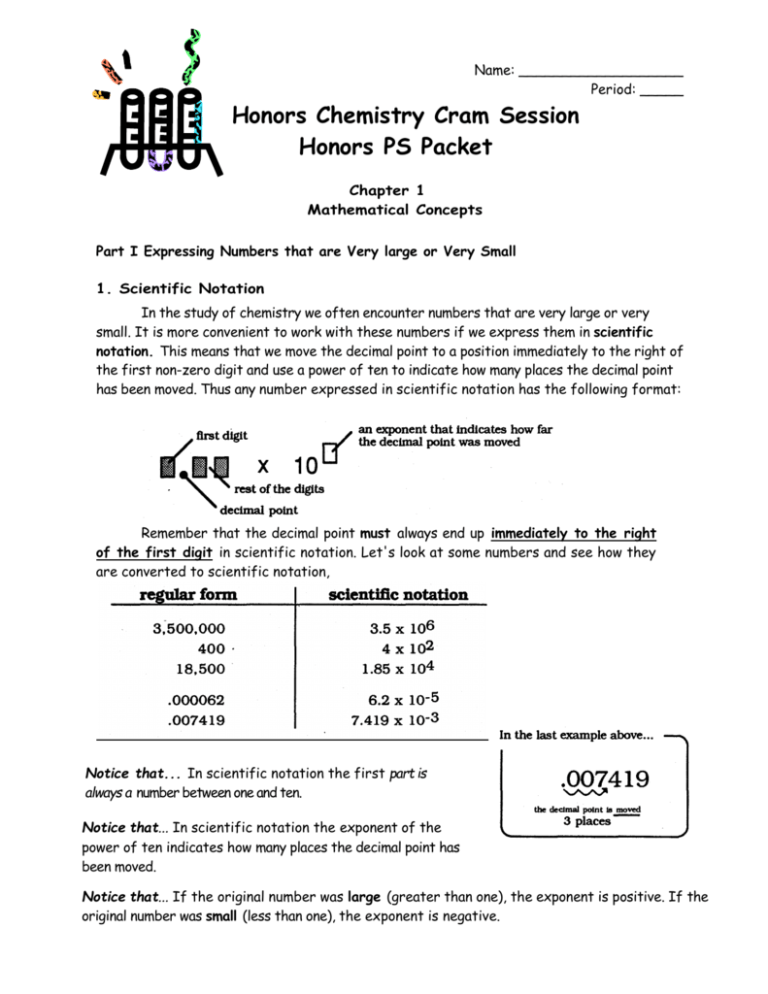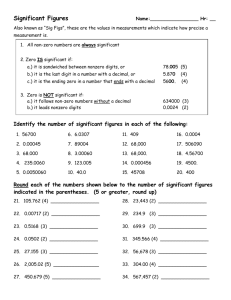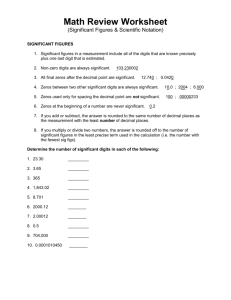Honors_Chem_Cram_Session_Packet
advertisement

Name: ___________________ Period: _____ Honors Chemistry Cram Session Honors PS Packet Chapter 1 Mathematical Concepts Part I Expressing Numbers that are Very large or Very Small 1. Scientific Notation In the study of chemistry we often encounter numbers that are very large or very small. It is more convenient to work with these numbers if we express them in scientific notation. This means that we move the decimal point to a position immediately to the right of the first non-zero digit and use a power of ten to indicate how many places the decimal point has been moved. Thus any number expressed in scientific notation has the following format: Remember that the decimal point must always end up immediately to the right of the first digit in scientific notation. Let's look at some numbers and see how they are converted to scientific notation, Notice that... In scientific notation the first part is always a number between one and ten. Notice that... In scientific notation the exponent of the power of ten indicates how many places the decimal point has been moved. Notice that... If the original number was large (greater than one), the exponent is positive. If the original number was small (less than one), the exponent is negative. Problems Copy each problem into your spiral notebook and convert each number into scientific notation. 1. 2. 3. 23,000 0.0045 241 4. 5. 6. 14.9 0.082 0.92 7. 8. 9. 121.1 40,000 0.00016 Copy each problem into your notebook. Then get rid of the scientific notation and express each as a regular number. 1.6 x 10-4 9.74 x 107 10. 11. 12. 13. 4 .0 8 8 x 1 0 5 6.05 x 10-9 2. Multiplication When we multiply numbers in scientific notation, we multiply the first part of each number as usual and add the exponents of the power of ten. Look over the following sample problems to see how this is done. Sample Problem 1 Solution Multiply: 1. Multiply 2 x 3 = 6 2. Add 4 + 5 = 9 Sample Problem 2 Solution (2 x l04) (3 x 105) the answer... 6 x 109 Multiply: 1. Multiply 4x2 = 8 2. Add (-5) + (+7) = +2 (4 x 10-5) (2 x 107) the answer... 8 x 102 3. Division When we divide numbers in scientific notation, we divide the first part of each number as usual and subtract the exponents of the power of ten (the top exponent minus the bottom exponent). Look over the next sample problems to see how this is done. Sample Problem 3 Solution 1. Divide 6 3 = 2 2. Subtract 9 – 5 = 4 Divide: 6 x 109 3 x 10 5 the answer... 2 x 104 Divide: 2 x 103 Sample Problem 4 4 x 10-9 Solution 1. Divide 2 + 4 = 0.5 2. Subtract (+3) - (-9) = +12 3. Move the decimal point to the standard position and adjust the power of ten accordingly. 0.5 x 1012 the answer... 5 x 1011 Remember... the decimal point must end up in the standard position, immediately to the right of the first digit. If it does not, it must be moved to the standard position. Then adjust the power of ten to compensate as follows: Sample Problem 5 Solution Divide: 1. Divide 2 8 = 0.25 2. Subtract (+3) - (+5) = -2 3. Move the decimal point to the standard position and adjust the power of ten accordingly. 2 x 103 8 x 105 0.25 x 10-2 the answer... 2.5x 10 -3 Problems Move the decimal point to its standard position and adjust the power of ten accordingly. 14. 15. 16. 0.85 x 105 42 x 108 16x104 17. 18. 19. 0.55 x 10 -23 0. 7 x 1 0 4 0.036 x 108 20. 248 x 10 -6 21. 0.6x102 22. 95x10-1 Problems Copy each problem into your notebook and do each calculation as indicated. Show any intermediate steps. Make sure your answers are expressed in correct scientific notation with the decimal point immediately to right of first digit. Problems Copy each problem into your notebook and do each calculation as indicated. Show any intermediate steps. Make sure your answers are expressed in correct scientific notation. Part II Expressing Accuracy in Measurements and Calculations 4. Accuracy Most of the numbers we work with in chemistry are measurements. In a mathematics class, the numbers which you have worked with are usually assumed to be exact and therefore you were only concerned with their value. But in science, since our numbers are measurements, each one has not only a particular value but also a particular accuracy. The accuracy of a measurement depends upon two things: the size of the measurement and its precision. Let's first look at the precision of a measurement, how it is determined, how it is expressed, and how it effects calculations. 5. Precision The precision of measurement depends upon the precision of the instrument used to make the measurement. In turn the precision of the instrument is determined by the smallest division readable on its scale. For example, if you measure several objects with the same meter stick which can be read to the nearest tenth of a centimeter, you might get measurements like the following: 2.5 cm, 5.8 cm, and 0.7 cm ---- all with the same precision )(i.e. accurate to the nearest tenth of a centimeter). Everyone has used a graduated cylinder to measure the volume of a liquid. Let's look at the difference in precision in the readings obtained using two different sizes of graduated cylinders. Size 1 The smallest division readable on this size graduated cylinder is tenths of a milliliter. Thus all of the readings on this instrument will be accurate to the nearest tenth of a milliliter. When the smallest division on the instrument is a tenth of a milliliter, ALL the measurements on that instrument must be made to a tenth of a milliliter!! If the reading lines up on a milliliter mark, like the third one above, a zero must be supplied for the tenths column to record the measurement to the correct precision. Size II The smallest division readable on this size graduated cylinder is milliliters. All of the readings on this instrument will be accurate to the nearest one milliliter. Precision Defined Thus we express the precision of a measurement by writing it out to the smallest division readable on the instrument used to make that measurement. This means expressing the measurement to the proper column (e.g. tens, ones, tenths, hundredths, etc.). You might notice that the third graduated cylinder above reads 10. mL rather than 10 mL. The decimal point in this reading tells us that the ones column has been measured even though it came out to zero. Without the decimal point, the zero would be just a place holder and would not indicate the precision to which the measurement was made. Trailing Zeros Indicate Precision Only if a Decimal Point is Shown 40 40. 300 300. 35,000 is measured to the nearest is measured to the nearest is measured to the nearest is measured to the nearest is measured to the nearest ten one hundred one thousand Problems Copy each problem into your notebook and indicate the precision of each number (to the nearest: hundred, ten, one, tenth, hundredth, etc.). 42. 42.796 46. 19 50. 6,000. 43. 0.72 47. 19.0 51. 200 44. 1.000 48. 400.0 52. 460 45. 145.8 49. 3,000 53. 30.0 When doing calculations involving measurements, the answer can only be as accurate as the least accurate measurement made. For addition and subtraction this can be expressed in the following rule: Sample Problem 7 Solution Sample Problem 8 Solution Problems Subtract: 246.58 - 87.3 Calculator answer ------------------> 159.28 Rounded to the correct precision --> (to the nearest tenth) 159.3 Add: 4.300. +928.6 Calculator answer ------------------> Rounded to the correct precision --> (to the nearest hundred) 5,228.6 5,200 Copy each problem into your notebook, do the addition or subtraction indicated, and round your answer to the correct precision. 7. Significant Figures The significant figures are the digits in a number which represent the accuracy of that number. All non-zero digits in a number are significant. But zeros may be just "place holders". The following two examples show the use of place holders in numbers. 0.085 This number has an accuracy of two significant figures. In this number the "8" and "5° are measured digits and are therefore significant. The zero is just a place holder that shows the position of the decimal point; it is not a significant figure. 400 This number has an accuracy of one significant figure. Trailing zeros are often only place holders. In this number the zeros are there to show that the "4" is in the hundreds column. Since no decimal point is shown, the zeros have not been measured and are not significant. For the beginner, it is often difficult to decide which digits are significant and which are not. For this reason, it is best to follow strictly a set of rules for determining the number of significant figures in any number. Rules for Determining Significant Figures 1. All non-zero digits are significant. 2. Zeros to the left of non-zero digits are NEVER significant. 3. Zeros between non-zero digits are ALWAYS significant. 4. Zeros to the right of non-zero digits are significant ONLY if a decimal point is shown. 'Notice that the terms left, between and right refer to the placement of the zeros in relationship with non-zero numbers NOT in relationship with the decimal point. All non-zero digits are always significant. The following examples illustrate the rules shown above as they apply to zeros: rule 2 rule 3 rule 4 number sig figs number sig figs 007 1 408 3 0.025 2 7.002 4 0.09 1 30.7 3 0.0081 2 50,009 5 number sig figs 600 8,500 1 2 30.0 46,000. 3 5 Problems Copy each problem into your notebook. Indicate the number of significant figures and list the rules (by number) that apply to each. 66. 247 71. 0.3 76. 200 67. 68. 69. 70. 2.47 4,105 0.1002 250 72. 73. 74. 75. 0.0074 8.00 62.000 0.030 77. 78. 79. 80. 0.04030 0.00007 3,000. 1,200 8. Multiplication and Division When multiplying of dividing numbers you must count the number of significant figures in each number and round off the answer to the same number of significant figures as the least accurate number. Sample Problem 9 Solution Multiply: Count significant figures ----------------------> (34.0) (.0921084) 3 S.F. 6 S.F. Calculator answer ---------------------------> 3.1316856 Rounded to the correct accuracy -----------> (to 3 significant figures) Sample Problem 10 Solution 3.13 534.168 0.07 Divide: Count significant figures -----------------------> 6 sig figs 1 sig fig Calculator answer -----------------------------> 76.30971 Rounded to the correct accuracy ---------> 80 (to 1 significant figure) Problems Copy each problem into your notebook. Label each number as to how many significant figures it contains. Write down your calculator answer and then the answer rounded to the correct accuracy. 81. (16.00) (.617289) 85. (560) (0.0031842) 82. 65.431 0.003 86. (0.050002) (406) 83. (.030040) (78.00000) 87. 30.5 0.050817 84. 0.8000 0.20 88. 128 16 9. Summary of Methods The most common mistake is to mix up the two methods we have learned for rounding. Here are the two rules we have learned: Mixed Problems Copy each problem into your notebook and show both your calculator answer and the final answer (rounded correctly). Be careful to use the right method for each problem. 10. Rounding Off When rounding off numbers, if what you drop off is greater than five, round up; if what you drop off is less than five, leave what remains alone. This rule will take care of 99% of all situations. But on the rare occasion in which the part you drop off is exactly five, round what remains to an even number. These three situations are illustrated below as each number is rounded to two significant figures. The special "round even" rule is used rarely since even a number such as 28.500001 will be rounded up to 29 (if rounded to two significant figures). This ruler illustrates how numbers that are exactly halfway round off to an even number. 11. Counting Numbers All of our discussion of accuracy and rounding has been directed to numbers that are measurements, as most of the numbers we deal with are. But occasionally we work with counting numbers. Numbers that have been arrived at by counting (rather than by measuring) are exact and have unlimited significant figures. To decide if a number is a counting number you must relate it to the context of the problem as illustrated in the next sample problem. Sample Problem 11 A new penny weighs 3.8 grams. How much do 7 new pennies weigh? 1. Multiply ---------------------------------------> 2. Number of Significant figures -------------> 3. Calculator answer ---------------------------> 3. Rounded off to the correct accuracy -----> (to 2 significant figures) (3.8) (7) 2 unlimited 26.6 27 12. Using Scientific Notation to Express the Correct Number of Significant Figures Once in a while we come across a number whose accuracy cannot be expressed correctly as a regular number. ---- For example: the number two hundred, if measured on an instrument which measures to the nearest ten, must be expressed as two significant figures. 105. (6.50) (330.) 106. 6650 700 107. (25) (32) 108. 2048 .256 109. A toothpick weighs 1.45 grams. How much do 70 toothpicks weigh? 110. A sample of metal is measured and found to be 37.42 inches in length. What. is its length in feet? (Twelve inches are "defined" to equal one foot. This is an example of a counting number, not a measurement.)









